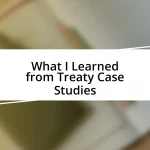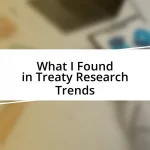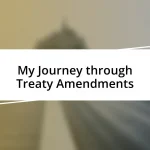Key takeaways:
- Anarchism emphasizes organized self-governance, fostering community through mutual aid rather than hierarchy.
- Key figures like Emma Goldman and Kropotkin highlight the connections between anarchism, feminism, and the natural instinct for cooperation.
- Practical applications of anarchism can be seen in community organizing and education, promoting collective decision-making and participation without centralized authority.
- Challenges include skepticism towards anarchism and navigating the balance between individual freedom and communal responsibility.

Understanding Anarchist Principles
Understanding anarchist principles is a journey through ideas that emphasize freedom, autonomy, and equality. When I first encountered these concepts, I felt a mix of excitement and confusion. Could a society truly function without structured authority? My reading and discussions opened my eyes to a diverse array of perspectives, each offering unique insights into how communities can thrive on mutual aid rather than hierarchy.
Anarchist principles are often misunderstood as chaos, but my experiences have taught me that they advocate for organized self-governance instead. For instance, I once participated in a local cooperative where decisions were made collectively. The sense of shared responsibility was empowering. It made me think: can shared decision-making lead to more creative and effective solutions? As I reflect on this, I realize that building trust and understanding in such environments is key to their success.
Exploring these principles requires delving into the belief that people are capable of self-organization. I remember a conversation with an old friend, who asked, “What if we all just did what we wanted?” It initially felt like a recipe for disaster. But as we discussed the potential for collaboration and community support, I became intrigued by the possibility of genuine cooperation without the need for top-down control—transforming our understanding of societal structures.

The Origins of Anarchism
Anarchism’s roots trace back to the 19th century, emerging as a reaction against the oppressive structures of capitalism and state power. When I first learned about figures like Pierre-Joseph Proudhon and Mikhail Bakunin, I felt a sense of connection; these thinkers challenged societal norms while advocating for individual freedoms. Their passion for dismantling hierarchical systems resonated with my own experiences of resisting authority in various forms.
Key aspects of the origins of anarchism include:
– The influence of Enlightenment thinkers who emphasized individual liberty and rationality.
– Proudhon’s famous declaration that “property is theft,” which questioned the very foundations of ownership.
– Bakunin’s belief in collective action and the idea that liberation comes from the people themselves, rather than from centralized authority.
– The role of labor movements in the late 1800s, where workers organized for their rights, embodying anarchist tenets in action.
– The tension between reformist and revolutionary approaches, sparking debates within anarchist circles about strategy and implementation.
Reflecting on these historical moments, I can’t help but think of my own encounters with authority in academic settings. Many times, I witnessed overbearing policies stifling creativity and innovation among my peers. It made me wonder—what if we could apply anti-authoritarian principles to education itself?

Key Thinkers in Anarchism
Understanding the contributions of key anarchist thinkers is crucial to appreciating the depth of anarchist theory. For instance, the works of Emma Goldman sparked my fascination with the connections between anarchism and feminism. I remember reading her passionate essays, which challenged the notion that gender roles must align with authority. It made me reconsider how traditional power dynamics influence personal relationships and, ultimately, societal structures. Her emphasis on individual freedom resonated deeply, urging me to explore how liberation is not just political but also personal.
Another pivotal figure, Kropotkin, introduced me to the idea of mutual aid as a natural human instinct, rather than a mere political concept. His arguments illustrated how cooperation underlies many successful communities. One memorable experience I had was volunteering in an urban garden, where everyone contributed freely, sharing resources and knowledge. Witnessing the fruits of our collective effort was genuinely uplifting. Kropotkin’s thoughts helped frame this experience as more than happenstance; it was a reflection of anarchist principles in action.
To further enrich your understanding of these influential figures, I think it’s helpful to compare their ideas in a structured format:
| Theorist | Main Contributions |
|---|---|
| Emma Goldman | Advocated for the integration of feminism and anarchism, emphasizing individual freedom and the critique of traditional authority. |
| Pierre-Joseph Proudhon | Formulated the concept of mutualism, challenging property rights and state power; famously stated that “property is theft.” |
| Mikhail Bakunin | Promoted the idea of revolutionary collectivism and the necessity of dismantling state structures through grassroots action. |
| Peter Kropotkin | Introduced the principle of mutual aid as a core component of human society, arguing that cooperation drives social progress. |

Practical Applications of Anarchism
One of the most striking practical applications of anarchism can be seen in community organizing. I remember my first experience with a local food co-op. It wasn’t just about buying groceries; it was a space where everyone had a voice and decisions were made collectively. I felt empowered, realizing we didn’t need a board of directors or a manager dictating terms. Instead, we thrived on mutual respect and collaboration. This experience illuminated how anarchist principles can lead to shared responsibility and a genuine sense of community ownership.
Another area where I’ve witnessed anarchism in action is in activist circles, particularly during protests. I recall joining a grassroots movement that emphasized leaderless organization. Initially, I was uncertain about the chaotic nature of it all. But, as we communicated and strategized openly, I became deeply invested in the process. No one person held authority, and our collective discussions ignited creative solutions. This taught me that, even in tumultuous settings, anarchism fosters innovation and resilience when we trust each other’s abilities.
Education also serves as a potent canvas for applying anarchist values. I found myself involved in an experimental learning program where traditional grading systems were replaced with collective feedback. At first, I was skeptical, wondering if accountability would falter. However, I soon discovered that the absence of hierarchical evaluation encouraged genuine participation and self-motivation among students. We empowered one another to learn, reflecting the core anarchist belief that liberation thrives in non-authoritative environments.

Challenges to Anarchist Principles
Navigating the principles of anarchism hasn’t been without its challenges for me. One significant hurdle is the skepticism many people exhibit toward the idea of living without a centralized authority. I recall having a friend who genuinely thought that without some form of government, chaos would dominate. This notion often makes it hard to have meaningful discussions about anarchism because it plants doubt in people’s minds. I often find myself asking: can we really imagine a society built on mutual cooperation instead of enforced rules?
Another challenge emerges when we try to implement anarchistic ideas in practice. I remember attending a community meeting intended to revise our cooperative’s decision-making process. While everyone was eager to contribute, the absence of a tangible framework led to confusion. People had passion, but without guidance, the discussions devolved into lengthy debates that lacked focus. This experience taught me that even within anarchist circles, some structure is necessary to foster effective collaboration. It’s fascinating, isn’t it? While striving for complete autonomy, we still grapple with the need for organization to avoid disarray.
Lastly, there’s the personal struggle with individualism versus collectivism. Anarchism advocates for a society based on mutual aid, but I’ve often found it challenging to balance this with my own desires and needs. During one particularly reflective moment, I had to confront the question of whether my needs should come first or if I should prioritize the community at large. It’s a constant push and pull that fosters growth but can also lead to discomfort. I’ve realized that these internal conflicts are part of the journey—each dilemma invites a deeper understanding of what it truly means to embrace anarchist principles.

Personal Reflections on Anarchism
I’ve found that embracing anarchist principles tends to stir up a whirlwind of emotions. There have been countless moments when I’ve felt a mix of exhilaration and doubt. For instance, when I first started participating in a book club focused on anarchist literature, I was energized by the ideas discussed. But there’s also that gnawing uncertainty: are these ideals realistic? I often ask myself if my enthusiasm can translate into real change when the world seems so steeped in hierarchical structures.
Reflecting on the nature of community is another aspect that has profoundly impacted me. I used to see community as simply a group of people living in close proximity. However, through various participatory projects, I’ve learned that it can be so much richer. I remember my days volunteering at a local mutual aid kitchen, a space where everything from the cooking to the distribution was shared. It struck me how deeply interconnected we became, each individual playing a vital role. It’s made me wonder: what if every community operated on the same principles of fairness and collective effort?
And then there’s the question of risk. Choosing anarchism often feels like stepping onto a tightrope—there’s the thrill of independence but also the fear of falling into chaos. I recall a time when my friends and I attempted to organize a community protest without any formal leadership. The energy was electric, yet the anxiety of uncertainty loomed large. Could we really pull it off? In the end, it worked out beautifully, but it leaved me pondering: is the leap worthwhile if it leads to deeper, more authentic experiences? Each of these reflections reveals just how complex and rewarding my journey through anarchist principles has been.

Lessons Learned from Anarchist Ideals
Exploring anarchist ideals has shifted my understanding of autonomy and community. One key lesson has been the importance of trust in relationships. I remember a moment during a neighborhood gathering when we decided to tackle a local issue collaboratively. It felt liberating to see everyone sharing ideas openly, without any higher authority dictating the discussion. This experience made me realize that a genuine connection fosters creativity and growth, reinforcing the idea that trust can be a far stronger glue than strict rules.
I also learned that challenging assumptions is vital for growth. When I participated in a discussion group on mutual aid, I candidly shared my initial belief that such initiatives were only temporary fixes. To my surprise, my peers offered compelling stories of how mutual aid transformed their lives. Their enthusiasm and real-life examples sparked something in me, leading me to ponder: what if these practices could redefine my understanding of support and solidarity? That insight deepened my appreciation for collective efforts, revealing that change often begins with simple conversations.
The struggle for balance between individual freedom and communal responsibility has been a significant eye-opener for me. I vividly recall an instance when I pushed myself to organize a community clean-up event. Despite my desire to create a shared experience, I faced the internal conflict of wanting to assert my vision versus allowing others to contribute their ideas. This tension left me with a crucial question: how can I embrace my individuality while honoring the collective spirit? I learned that finding this balance is not just a necessity, but a beautiful journey towards mutual respect and understanding in anarchist practice.














